Lower Menominee River- Delisted Area of Concern
About
About the Lower Menominee River AOC
The Menominee River flows into Green Bay and forms the boundary between northeast Wisconsin and Michigan's Upper Peninsula. The Menominee River Area of Concern (AOC) boundary includes the lower 3 miles of the Menominee River from the Park Mill Dam (Upper Scott Dam) to the river mouth and extends approximately 3 miles north of the river mouth along the adjacent Green Bay shoreline to John Henes Park and 3 miles south of the river mouth along the adjacent Green Bay shoreline, including Seagull Bar.
The AOC boundary includes portions of Marinette County in Wisconsin and Menominee County in Michigan and is within the city of Marinette, Wisconsin, and the city of Menominee, Michigan. The AOC includes six permanent islands: Blueberry, Little Blueberry, Boom, Stephenson and Strawberry, which are found within the lower 3 miles of the Menominee River; and Green Island, which is located in Green Bay approximately 5 miles east of Seagull Bar.
The DNR shares oversight of this AOC with the Michigan Department of Environment, Great Lakes and Energy (EGLE). The two states are responsible for implementing Remedial Action Plans, which guide the restoration of beneficial uses in this AOC.
Officially Delisted
After decades of hard work, all the necessary actions to clean up and restore the Lower Menominee River Area of Concern have been completed and restoration goals have been achieved and documented. Six problems, called "Beneficial Use Impairments" in the AOC Program, that were listed for the Lower Menominee River have also been formally removed.
The DNR and Michigan EGLE provided the U.S. EPA's Great Lakes National Program Office with a final delisting report that summarizes the cleanup and restoration actions. As part of the delisting process, Wisconsin and Michigan held a public comment period from March 9 - April 24, 2020, and hosted a public meeting on April 9, 2020. The EPA then took the final step with the U.S. and Canadian governments to officially remove the Area of Concern designation, effective August 14, 2020. The delisting of the Lower Menominee River is a significant milestone in the restoration of the Great Lakes and a notable success under the Great Lakes Water Quality Agreement and the Great Lakes Restoration Initiative.
Community Engagement
Community Advisory Committee (CAC)
The Citizen's Advisory Committee (CAC) exists to assist State and Federal Agencies to identify local issues, define restoration targets and goals, serve as a resource for historical information, and implement small scale restoration and community outreach activities. The CAC is made up of area citizens who are devoted to restoring the Lower Menominee River. Meetings are open to public attendance and advertised on DNR's public meetings calendar. Non-member public participation at Citizen's Advisory Committee meetings is limited, but all meetings are open for public comment prior to close.
If you're interested in becoming a formal, voting member of the Lower Menominee River Citizen's Advisory Committee, please carefully review the CAC bylaws and contact Brie Kupsky.
Get involved
To learn more about AOC community events, volunteer opportunities and more, check out the Citizens Advisory Committee's Facebook page.
Maps
Maps
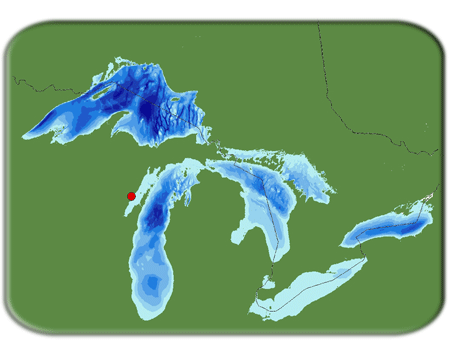
Impairments
Impairments
Most of the beneficial use impairments (BUIs) listed for the Lower Menominee River AOC were caused by the presence of contaminated sediment. Pollutants of concern identified in the AOC included the following:
- arsenic;
- paint sludge;
- coal tar;
- mercury;
- polychlorinated biphenyls (PCBs); and
- oil and grease.
Log driving, urbanization, invasive species, habitat fragmentation, loss of wetlands and municipal combined sewer overflows have also contributed to impairments in the AOC.
Of the 14 beneficial uses, six were originally listed as impaired in the Lower Menominee River Remedial Action Plan (1990).
- Restrictions on fish and wildlife consumption
- Degradation of fish and wildlife populations
- Restrictions on recreational contact
- Degradation of benthos
- Restrictions on dredging activities
- Loss of fish and wildlife habitat
BUI removal
The following is a list of BUI removal packages with cover letters and U.S. Environmental Protection Agency concurrence letters.
- Degradation of fish and wildlife populations; Loss of fish and wildlife habitat - These two BUIs were removed as a joint package in February 2019
- Restrictions on fish and wildlife consumption - BUI removed June 2018
- Restrictions on dredging activities – BUI removed May 2017
- Degradation of benthos – BUI removed May 2017
- Restrictions on recreational contact - BUI removed March 2011
The Lower Menominee River AOC completed all management actions in 2016. Sources of pollutants within the AOC boundaries have been controlled through remedial action projects. These projects were monitored according to their approved plans and have met cleanup goals. The fish and wildlife habitat restoration projects that were implemented were also monitored according to their approved plans and have met their restoration goals. Successful remediation and restoration of the Lower Menominee River AOC has been possible with the help of many partners. Great Lakes Restoration Initiative (GLRI) funding has been a critical component of this restoration effort.
AOC Plans
AOC plans
- 2017 RAP Update
- 2016 RAP Update
- 2015 RAP Update
- 2014 RAP Update
- 2013 RAP Update
- 2013 Fish and Wildlife Plan
- 2012 Stage 2 Remedial Action Plan Update
- 2011 Stage 2 Remedial Action Plan
- 2011 Fish and Wildlife Populations and Habitat Management and Restoration Plan
- 2008 Lower Menominee River AOC Beneficial Use Impairment Restoration Targets
- 1996 Lower Menominee River Remedial Action Plan Update
- 1995 Working Together to Improve and Protect the Great Lakes: A Summary of the Lower Menominee River RAP
- 1993 Remedial Action Plan Progress Report
- 1990 Stage 1 RAP Report: Lower Menominee River Remedial Action Plan: A Water Quality Restoration and Protection Plan
Resources
Contacts
- Brie Kupsky
Lower Menominee River AOC coordinator
Wisconsin Department of Natural Resources - Stephanie Swart
AOC coordinator
Michigan Department of Environment, Great Lakes and Energy (EGLE)
SwartS@michigan.gov
517-284-5046
EGLE Menominee River AOC
Resources and Reports
- Lower Menominee River Accomplishments
- Lower Menominee River Area of Concern: Removed from the list of Great Lakes AOCs
- 2019 Menekaunee Harbor and South Channel Maintenance Plan
- 2019 Menominee River Islands Invasive Species Management Report
- 2016 Fish Reference Site Monitoring Final Report
- 2016 Larval Lake Whitefish Report
- 2015 Lower Menominee River 3 Panel Display
- 2014 eBird Data Assessment Final Report
- 2014 Fish Reference Site Monitoring Interim Report
- 2013 Fish Reference Site Monitoring Interim Report
- 2012 Fisheries Data Roundup final report
- 2012 Riparian Vegetation Survey Report
- 2012 Semi-Permeable Membrane Device (SPMD) Study Report
- 2011 Mussel Survey Report
- 2010 Aquatic Vegetation Survey Report
Videos
- Remediation, Restoration, Revitalization - Menekaunee Harbor [exit DNR]
- Menekaunee - Bringing the Harbor to Life [exit DNR]
- Menominee River Area of Concern: Changing Waters [exit DNR]
- The Sturgeon Passage: Up River Refuge [exit DNR]
- The Sturgeon Passage: Getting a Lift [exit DNR]
Fish consumption advice for the Menominee River Area of Concern
State natural areas
Projects
Green Bay Paint Sludge Site
Since the early 1900s, a manufacturing plant in Menominee, Mich. (now Lloyd Flanders International) has produced woven wicker and metal furniture. Operations involved plating of metal parts and spray painting of metal and wicker components. Until the late 1980s, furniture production processes used curtains to capture paint mists and overspray which generated large volumes of paint sludge. The painting and plating process contained heavy metals, including high levels of lead. The overspray containing bulk paint wastes collected at the bottom of the painting booths. These paint wastes, along with other manufacturing wastes, were then dumped behind the plant, along the adjacent the shoreline or flushed out to the bay of Green Bay.
A Resource Conservation and Recovery Act (RCRA) Administrative Order on Consent resulted in the removal of over 30 million pounds of hazardous waste and contaminated sediment from the bay of Green Bay at the Lloyd Flanders paint sludge site from 1993 to 1998. Lloyd Flanders continues to remove any residual paint balls that collect on the shoreline.
Ansul/Tyco Arsenic Site
The Ansul Fire Protection Company (known during remediation as Tyco Fire Products Limited Partnership and now known as Johnson Controls) generated arsenic salts at their manufacturing site in Marinette, Wis., adjacent to the turning basin in the river. Arsenic salts were generated as a byproduct of herbicide manufacturing between 1957 and 1977. The waste salts were stored on-site in a bunker area and in uncovered piles. They were then discharged directly to the river via storm water runoff and wind erosion, and indirectly by leaching into surface and ground water which then flowed to the Menominee River along the turning basin.
In conjunction with a 2009 RCRA Administrative Order on Consent and a 2014 Great Lakes Legacy Act Betterment Action, Tyco International removed 302,000 cubic yards of arsenic contaminated sediments from 2012–2014. Sediment sampling conducted to monitor natural recovery, as established in the Consent Order, will continue every five years.
Wisconsin Public Service Corporation (WPSC) Coal Tar Site
The WPSC site is in Marinette and operated from 1910 to 1960 using two coal gasification methods that created non-aqueous phase liquid (NAPL) and dense non-aqueous phase liquid (DNAPL) byproducts. Coal tars contain polyaromatic hydrocarbons (PAHs) and other site-specific processing contaminants including sulfur, heavy metals and metalloids such as mercury and arsenic.
An Administrative Order on Consent resulted in removal of 15,000 cubic yards of contaminated sediments from 2012–2013; goal assessments were complete and met by 2015.
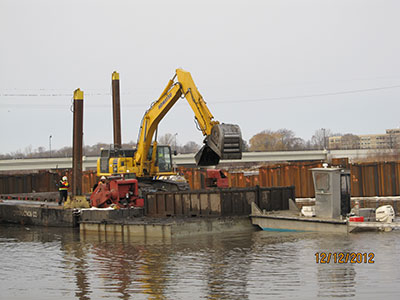
Dredging at WPSC coal tar site in 2012.
Menekaunee Harbor Dredging and Restoration Project
Menekaunee Harbor was contaminated with heavy metals and PAHs, which were believed to originate primarily from historical industrial operations and storm water input bordering the harbor. The city of Marinette partnered with the DNR and EPA to implement a dredging plan that addressed contaminated sediment while also allowing for navigational improvements to the harbor.
A total of 59,000 cubic yards of contaminated and excess sediments were removed from the harbor in 2014. The clean dredge material was beneficially used to improve fish and waterfowl habitat in the undeveloped portion of the harbor. A sand cover was also placed over areas of low-level residual contamination. Remedial action goals were met in 2015, while also improving navigation in the harbor.
Additional in-water and upland habitat restoration work provided 0.6 miles of improved shoreline habitat and 24 acres of wetland and upland habitat improvements through invasive species removal, native species plantings and installation of habitat structures for birds, bats, herptiles and fish.
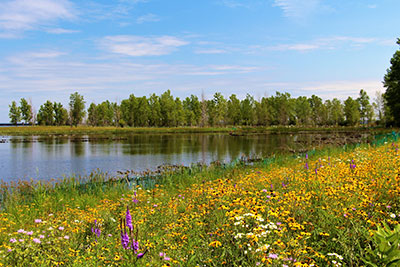
Restored Menekaunee Harbor.
South Channel Habitat Restoration Project
Just upstream of Menekaunee Harbor, the South Channel project took place after contaminated sediment was removed from the Tyco/Ansul Arsenic site. A total of 110 acres and 1.6 miles of shoreline were restored through removal of invasive species, native species plantings and installation of habitat structures for northern pike, herptiles, songbirds, bats, raptors and waterfowl. Rip rap and sediment was also removed from under the Ogden Street Bridge to improve water flows and overall connectivity between South Channel and Menekaunee Harbor, allowing fish to pass through this area once again.
Menominee River Fish Passage Project
The Menominee and Park Mill dams were constructed in the 1920s to produce hydropower for industries in the cities of Marinette and Menominee, but they also created a barrier that prevented lake sturgeon from accessing the river for spawning and habitat. Fish passage was restored over these dams in 2016, returning an 18-mile stretch of prime spawning habitat for lake sturgeon. Fish are lifted over the Menominee Dam to a sorting station where biologists select healthy adult sturgeon over 50 inches long to be passed upstream. Once they are above this dam, adult sturgeon are loaded into a trailer for transport to an upstream release point above the Park Mill dam.
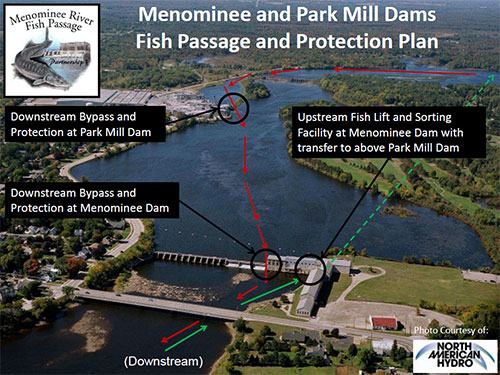
Overview of the fish passage. Courtesy of Rob Elliot, North American Hydro.
Lower Menominee Islands Rookery and Habitat Management Project
This project re-established rookery habitat on four river islands in the AOC (Little Blueberry, Big Blueberry, Strawberry and Boom Islands) for impaired colonial nesting water-bird populations. Habitat restoration activities included mapping and removal of invasive species and aggressive native species impacting rookery habitat and native species plantings.
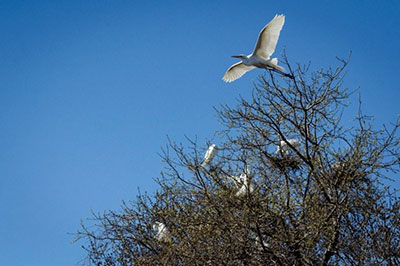
Great Egrets nesting at the Strawberry Island Colonial Waterbird Rookery. Courtesy Ecology & Environment, Inc.
